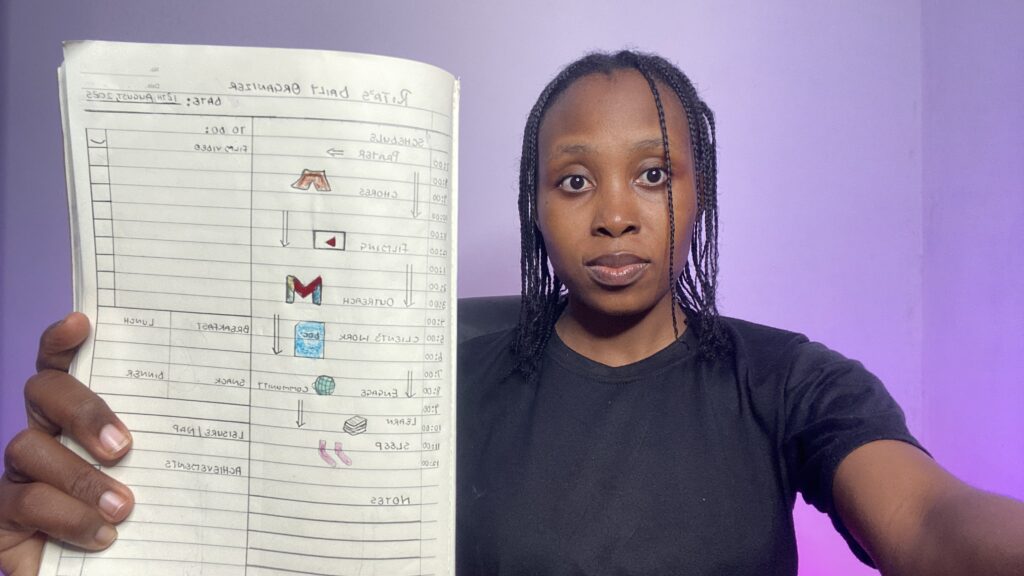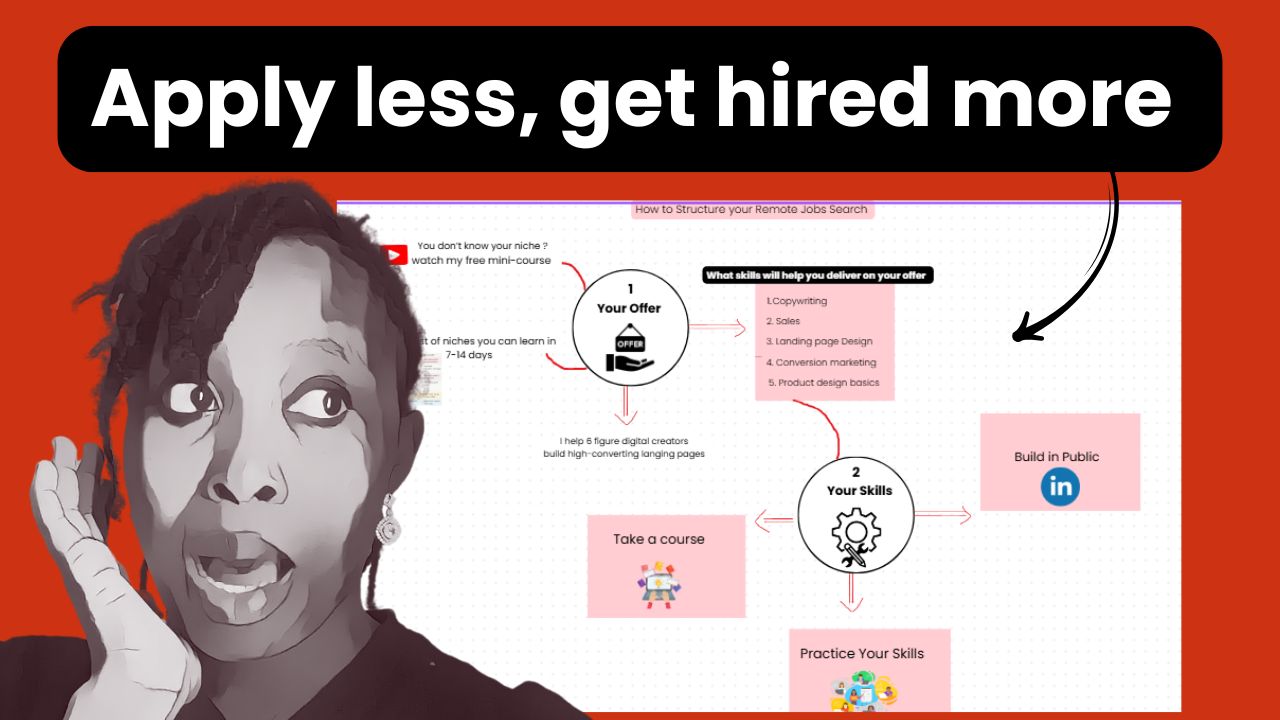It’s painful, I know.
Spending hours applying for jobs and hearing nothing back, not even a rejection.
I get how you feel because I have been there. It feels like it is finally “this one job” – until you apply to 79 more jobs only to hear CRICKETS.
- 7 months have already gone by
- Your account balance is red
- You are asking weird questions like: “What is wrong with me?”
Well, it’s not all thorns and woes. I believe I have identified a possible solution to your problem. I discovered this solution after receiving numerous rejections myself, and I will be sharing it with you.
It is not what you think (not a hidden job website). It is simply about “Being Organized”–
I know it sounds like “meh”, but stay with me as I walk you through my exact remote job search organization strategy.
This single strategy has increased my response rate by over 79% while keeping me sane in this crazy job market:)
First, why does this strategy matter?
Regularly applying for jobs is the “single hardest” way to get a job in 2025. That is because things have changed. And most of the time, someone has gotten hired or is being interviewed for the same job you are waiting to hear back.
It’s unfair, but that’s just how it is.
Applying randomly to dozens or hundreds of roles wastes time and energy. Employers want proof that you can do the job, not another generic CV that will be parsed by ATS. The smarter approach is to organize your job search, build credibility, and reach out strategically. That way, you apply to fewer jobs—and get better results.
Okay, let’s go straight to the steps.
Step 1 — Know Your Offer
Before you hit “apply,” be crystal clear about what you offer. Your offer should answer the questions: what service do I provide, and who benefits from it?
- Discover your niche. Narrow down the category you want to play in (example: landing pages for digital creators).
- Define your ideal client. Are you targeting indie hackers, startups, course creators, or enterprises? That determines where you spend your energy
Example: “I help six-figure digital creators build high-converting landing pages.” That sentence streamlines outreach and discovery.
Step 2 — Identify & Improve the Skills You Need
Once you know your offer, list the skills required to deliver it well. If you want to build landing pages, relevant skills might include:
- Copywriting and sales fundamentals
- Landing page design and conversion optimization
- Basic product and UX design
Take courses to learn and refresh these skills. But remember: taking a course doesn’t make you a professional. Practice does.
Step 3 — Practice, Practice, Practice
After learning, put your skills into practice. Do free or low-paid projects, build passion projects, volunteer, or work for friends and family. Real work produces proof—samples, case studies, and testimonials—that employers can evaluate.
Two important habits here:
- Build in public: Share what you’re learning and building on social platforms. I recommend LinkedIn first because it hosts professionals and international audiences; research shows a significant portion of LinkedIn users are in the U.S., which helps visibility for remote roles.
- Be consistent: Regular posts and public work help employers see you can do the job before they even ask.
Step 4 — Discover What Works for You
Your niche often evolves. As you practice and publish, patterns will emerge: the projects that get traction, the work you enjoy, and the outcomes that clients applaud. Double down on what works.
Remember: you don’t always find a niche at the start—your niche finds you as you show up and do the work.
Step 5 — Research Ideal Employers & Put Your Work Where They Can Find It
When you’re ready to look for jobs, don’t spray-and-pray. Research where your ideal clients or employers hang out and show up there.
- Create gigs on freelance marketplaces (Upwork, Fiverr, Behance, etc.)—even if you don’t plan to live there. A presence can bring inbound leads.
- Keep your portfolio and sample work visible. You never know who will find you.
Step 6 — Do the Work Before You Pitch
Instead of sending a CV and hoping, do an example of the work for the brand you want to work with. For instance, if you design landing pages, rebuild a landing page from a course creator and send it as a tailored sample. Doing the work demonstrates capability and drastically increases response rates.
Step 7 — Reach Out Using the “Beyond & Above” Strategy
I use a targeted outreach method I call the Beyond & Above Strategy. It’s a value-first outreach approach that consistently generates strong response rates—often 70–80% in my experience. The key elements are:
- Research the prospect thoroughly (company, product, recent launches).
- Deliver a personalized, tangible piece of work or insight that shows immediate value.
- Follow up with concise, human messages that reference your sample and the specific benefit you can provide.
Pro Tip: Always use a high-converting portfolio when reaching out to prospective clients. I studied over 103 remote work portfolios and created the best portfolio template.
If you’re interested in learning the full step-by-step of this strategy, you can join my waitlist: https://ritamichaeladegoke.com.ng/beyond-above-strategy-waitlist/
How I Organize My Job Search Day-to-Day

Applying less doesn’t mean doing nothing. It means organizing your days so you spend time improving, creating proof-of-work, and reaching out strategically. I built a daily organizer that keeps me balanced and productive. Key sections I include:
- Hourly schedule (prayer, chores, content filming, client outreach, client work, learning)
- To-do list with check-off items for momentum
- Meal reminders and rest/leisure slots to prevent burnout
- Achievements section to track progress and celebrate wins
- Notes area for patterns, lessons learned, and tomorrow’s priorities
This structure prevents endless, low-value applications and encourages activities that build credibility: creating, publishing, networking, and targeted outreach.
Quick Daily Routine Example
- Morning: Personal routine and brief learning session
- Mid-morning: Create or polish a sample (portfolio piece)
- Afternoon: Targeted outreach using the beyond & above approach
- Late afternoon: Client work or practice projects
- Evening: Publish an update (LinkedIn post) and record achievements/notes
Free Resources I Mentioned
Grab the flowsheet I used in this video: https://ritamichaeladegoke.com.ng/beyond-and-above-strategy/
Join the waitlist for the full Beyond & Above course: https://ritamichaeladegoke.com.ng/beyond-above-strategy-waitlist/
Watch my free mini-course on finding your niche: https://www.youtube.com/watch?v=MFcjuA0Vljc&t=31s
Actionable Checklist (Start Today)
- Write a one-sentence offer (who you help + how).
- List 3–5 core skills required to deliver that offer.
- Take one relevant course and complete one small project from it.
- Publish that project publicly (LinkedIn recommended).
- Research 5 ideal employers or clients and create tailored sample work for each.
- Create gigs/profiles on at least one freelance marketplace.
- Use the beyond & above approach to reach out to those 5 prospects.
- Use a daily organizer to track tasks, meals, rest, and achievements.
Final Thoughts
Applying to hundreds of jobs is exhausting and rarely effective. The smarter path in 2025 is to build the right skills, publish proof, research your targets, and reach out with real value. Do the work, be visible, and apply strategically. That’s how you apply less and get hired more.
If you want the flowsheet and starter materials I used, grab them here
When it comes to applying for jobs and getting actual responses, I developed a strategy I called the Beyond & Strategy. I have used this strategy and have gotten results almost every time.
I am creating a mini-course to break down this strategy (sharing exact screenshots, responses, and my exact steps). This is simply the full system for applying for a few jobs and getting more responses. If you are interested in this course, click on the link below to join the waitlist:
https://ritamichaeladegoke.com.ng/beyond-above-strategy-waitlist/
“It’s not the number of jobs you apply to that matters—it’s the quality of the work you show and the way you present it.”
Spend time to build and create things that are valuable to your target clients, put it out there. Then sit and watch opportunities look for you.
If you try this system, let me know how it goes. Keep showing up, building in public, and creating proof. Good luck—I’ll see you on the other side.
